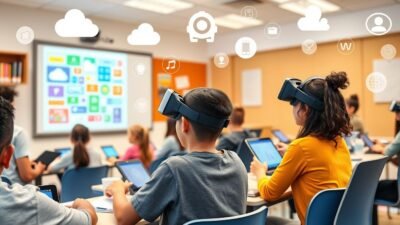Effective classroom communication is crucial in India’s higher education system. It’s a key skill for aspiring educators preparing for the UGC NET Paper 1 exam. Understanding communication principles can transform the learning experience for students and teachers alike.
Are there hidden strategies that can revolutionize classroom interactions? Let’s explore untapped methods to enhance teaching and learning.
We’ll explore effective classroom communication, focusing on its foundations and active listening techniques. We’ll also look at culturally responsive strategies that can improve the teaching-learning dynamic.
We’ll uncover ways to master nonverbal cues and build strong teacher-student relationships. These tools can help break down communication barriers and create a thriving educational environment.
This exploration will equip you with skills to excel in UGC NET Paper 1 and beyond. Let’s unlock the secrets of engaging classroom communication together.
Key Takeaways
- Understand the significance of effective classroom communication in the context of UGC NET Paper 1
- Explore strategies for enhancing teaching aptitude through communication techniques
- Learn about the core components of classroom interaction and their impact on learning outcomes
- Discover active listening methods to improve teaching effectiveness
- Understand the role of nonverbal communication and cultural responsiveness in the classroom
Understanding the Foundations of Classroom Communication
Effective classroom communication is vital for successful teaching and learning. In Indian higher education, mastering communication is crucial for engaging students. Educators can improve student engagement by understanding classroom communication foundations.
Defining Communication in Educational Settings
Classroom communication involves exchanging information, ideas, and perspectives between teachers and students. It includes transmitting knowledge, facilitating discussions, and creating a collaborative learning atmosphere.
Mastering classroom management strategies and student engagement methods is key. These skills help create an environment that promotes meaningful communication.
The Impact of Effective Communication on Learning Outcomes
Clear, engaging, and responsive classroom communication greatly affects student learning outcomes. It helps students better understand course content and encourages critical thinking.
Effective communication also promotes active participation. By improving their skills, educators can unlock students’ potential and empower them.
Core Components of Classroom Interaction
- Active listening: Attentively hearing and understanding students’ perspectives and concerns
- Questioning techniques: Using open-ended and probing questions to stimulate discussion and deepen understanding
- Nonverbal communication: Effectively using body language, facial expressions, and gestures to enhance the learning experience
- Feedback and clarification: Providing constructive feedback and addressing any ambiguities or misunderstandings
Mastering these core components helps educators create engaging learning environments. This approach caters to diverse student needs in India’s higher education landscape.
“Effective communication is the lifeblood of the classroom, enabling students to thrive and reach their full potential.”
Active Listening Techniques for Enhanced Teaching
Communication is key to successful teaching in the classroom. Active listening is at the core of this skill. It improves teacher-student relationships and enhances learning experiences.
For UGC NET Paper 1, aspiring educators must master active listening techniques. These skills are vital for their professional growth. They help create a more effective learning environment.
Paraphrasing is a key active listening technique. Teachers show they’re paying attention by restating students’ words. This helps ensure both parties understand each other clearly.
- Paraphrasing: Restating a student’s comments in your own words to confirm understanding and show genuine interest.
- Clarifying: Asking for elaboration or additional details to gain a deeper insight into the student’s perspective.
- Reflecting: Mirroring the emotions expressed by the student to create a supportive and empathetic environment.
Eye contact and avoiding distractions are crucial for active listening. These non-verbal cues show students their voices matter. They build trust and respect between teachers and students.
| Active Listening Technique | Description | Benefits |
|---|---|---|
| Paraphrasing | Restating a student’s comments in your own words | Demonstrates attentiveness and ensures mutual understanding |
| Clarifying | Asking for elaboration or additional details | Gains deeper insight into the student’s perspective |
| Reflecting | Mirroring the emotions expressed by the student | Creates a supportive and empathetic environment |
Mastering active listening creates an engaging and empowering learning environment. It boosts academic performance and helps students develop holistically. Understanding active listening is crucial for UGC NET Paper 1 aspirants.
These skills set future educators on a path to excellence. They contribute to better teaching practices and improved student outcomes.
“Listening is the essence of effective communication. It is the key to building strong relationships, understanding diverse perspectives, and creating meaningful connections in the classroom.”
Nonverbal Communication Skills in the Classroom Setting
Nonverbal communication is vital in the classroom. It engages students and improves learning. Mastering these skills can boost your teaching and classroom management abilities.
Body Language and Facial Expressions
Your body language speaks volumes to students. A warm posture, steady eye contact, and genuine smile create trust. Crossed arms or fidgeting can signal discomfort, hindering classroom communication.
Spatial Awareness and Classroom Positioning
Your movement in the classroom affects communication. Strategic positioning helps connect with all students. It ensures everyone feels included and engaged.
Being aware of your location helps monitor student engagement. You can quickly address any issues that arise.
Visual Cues and Gestures
Visual cues and gestures enhance classroom communication. Pointing, nodding, or using hands can reinforce your message. These actions keep students engaged.
Visual aids like charts or diagrams help explain complex ideas. They facilitate deeper understanding among students.
These skills create a dynamic classroom environment. They foster learning and build strong teacher-student relationships. Your teaching aptitude will shine during evaluations like the UGC NET Paper 1 exam.
| Nonverbal Communication Skill | Classroom Application | Impact on Classroom Management |
|---|---|---|
| Body Language and Facial Expressions | Maintaining an open and approachable posture, making eye contact, and displaying a welcoming smile | Promotes trust, engagement, and a positive learning environment |
| Spatial Awareness and Classroom Positioning | Strategically moving around the classroom to monitor student engagement and address any issues | Enhances classroom management by ensuring all students feel included and supported |
| Visual Cues and Gestures | Using hand gestures, pointing, and incorporating visual aids to reinforce key concepts | Helps students better understand and retain information, leading to improved learning outcomes |
Use these nonverbal skills in your teaching practice. They create an engaging classroom environment. Your teaching aptitude will improve, helping you succeed in the UGC NET exam.
Building Strong Teacher-Student Rapport
A positive relationship between teachers and students is vital for an engaging learning environment. Strong teacher-student rapport unlocks students’ potential, leading to better academic performance. This bond creates a more rewarding academic career for both parties.
Positive reinforcement strategies are key in cultivating this rapport. Acknowledging achievements and providing constructive feedback boosts morale and motivation. This approach creates a classroom culture that celebrates success.
- Personalize interactions by learning about students’ interests and backgrounds
- Offer sincere praise and recognition for both academic and non-academic accomplishments
- Provide timely and specific feedback to help students identify areas for improvement
- Encourage students to take active roles in their own learning process
- Foster a collaborative environment where students feel safe to share their ideas and ask questions
Strong teacher-student relationships benefit students beyond the classroom. Students who feel valued engage more actively in their studies. They develop a positive attitude towards learning and achieve greater academic career success.
| Strategies for Building Strong Teacher-Student Rapport | Benefits for Students |
|---|---|
| Personalized interactions | Increased motivation and engagement |
| Positive reinforcement | Improved self-confidence and academic performance |
| Constructive feedback | Better understanding of their strengths and areas for growth |
| Collaborative learning environment | Enhanced critical thinking and problem-solving skills |
Prioritizing teacher-student rapport creates an inspiring learning environment. It fosters student growth and sets the stage for long-term academic career success. This approach benefits both educators and learners alike.
“The best teachers are those who show you where to look, but don’t tell you what to see.”
Culturally Responsive Communication Strategies
Indian classrooms are rich with cultural diversity. Effective communication strategies that embrace this diversity are crucial. Educators can create an engaging learning environment by understanding cultural nuances and using inclusive language.
Understanding Cultural Diversity in Indian Classrooms
India’s higher education system is a blend of cultures and traditions. Recognizing this diversity is key for culturally responsive teaching. Educators must be aware of students’ unique perspectives and learning styles.
This awareness helps create an atmosphere of mutual understanding and respect. It allows teachers to adapt their methods to suit various cultural backgrounds.
Inclusive Language Practices
- Utilize inclusive language practices that are sensitive to diverse cultural identities and experiences.
- Avoid language that may be perceived as biased or exclusionary, and instead, adopt a inclusive and affirming tone.
- Encourage students to share their own cultural narratives, enriching the learning environment.
Cultural Sensitivity in Teaching Methods
Integrating cultural sensitivity into teaching methods enhances learning in higher education in India. This involves using diverse learning materials and acknowledging cultural traditions. Teachers can adapt their approaches to suit various learning styles.
“Culturally responsive teaching is not just about what we teach, but how we teach it.”
Culturally responsive strategies create a more inclusive classroom. They empower students to thrive in a culturally responsive teaching environment. This approach benefits all students, regardless of their background.
UGC NET Paper 1: Communication Principles for Aspiring Educators
Mastering effective communication is crucial for success in the UGC NET Paper 1. This exam opens doors to lectureship positions in India. It tests understanding of core communication principles in teaching and learning.
UGC NET Paper 1 focuses on communication’s role in academics. Aspiring educators must grasp key areas to excel in this exam.
- Interpersonal Communication: Showcasing the ability to engage in interactive dialogues with students, fostering a dynamic and inclusive classroom environment.
- Nonverbal Communication: Mastering the art of body language, gestures, and facial expressions to enhance the delivery of course content and connect with the audience.
- Active Listening: Demonstrating the skill to attentively and empathetically engage with students, understanding their perspectives and responding effectively.
- Presentation Skills: Crafting and delivering engaging, informative, and impactful presentations that captivate the audience and convey complex ideas with clarity.
Improving these skills boosts chances of success in UGC NET Paper 1. It also makes candidates attractive for lectureship roles in India’s higher education system.
“Effective communication is the foundation of successful teaching and learning. Aspiring educators must prioritize the development of these crucial skills to thrive in the UGC NET examination and beyond.”
Understanding communication principles is vital for aspiring educators. It shows readiness to shape India’s educational future. This knowledge empowers the next generation of learners.
Technology Integration for Enhanced Classroom Interaction
Technology has changed how teachers and students interact in classrooms. Digital tools and virtual platforms offer endless ways to improve learning. These advancements help students develop research methodology, data interpretation, and logical reasoning skills.
Digital Tools for Communication
Modern classrooms use various digital tools for better communication. Interactive whiteboards and video conferencing software enable real-time student engagement. Cloud-based platforms encourage knowledge-sharing and discussions.
These tools enhance research methodology and data interpretation. They also help students improve logical reasoning through interactive activities and simulations.
Virtual Learning Platforms
The pandemic has sped up the use of virtual learning platforms. These digital spaces give students easy access to course materials and interactive lessons. They also provide collaborative areas for remote learning.
Teachers can track student progress and give personalized feedback using these platforms. This nurtures critical thinking skills essential for research methodology, data interpretation, and logical reasoning.
Blended Communication Approaches
The best strategies often mix digital and traditional methods. This blend creates a dynamic learning experience for different learning styles. It allows smooth shifts between online and in-person activities.
This approach helps develop research methodology, data interpretation, and logical reasoning skills.
| Digital Tools for Classroom Communication | Virtual Learning Platforms | Blended Communication Approaches |
|---|---|---|
|
|
|
Technology creates an engaging learning environment that builds essential skills. Digital tools, virtual platforms, and blended approaches help teachers and students thrive. This integration empowers education in our ever-changing world.
Overcoming Communication Barriers in Diverse Classrooms
Creating inclusive learning in India’s diverse classrooms is vital yet challenging. Instructors must navigate communication barriers that can hinder student engagement. Effective strategies can help educators overcome these obstacles and foster meaningful dialogues.
Developing conflict resolution skills is key. It empowers students to address interpersonal issues constructively. Techniques like active listening and open-ended questioning promote collaborative problem-solving.
- Encourage open and respectful communication among students
- Facilitate constructive dialogue around sensitive topics
- Teach conflict resolution strategies that can be applied in and beyond the classroom
Inclusive language practices are equally important. Educators must use terms that resonate with students from diverse backgrounds. This means avoiding biased language and respecting cultural differences.
“Inclusive language practices are essential for creating a welcoming and supportive learning environment for all students.”
Culturally responsive teaching is crucial for overcoming communication barriers. It involves understanding students’ cultural frames of reference. Teachers can then design engaging and relevant lesson plans.
Addressing communication challenges requires a multi-faceted approach. Educators can create an empowering environment through various strategies. This allows all students to express thoughts and engage in meaningful discussions.
Conclusion
Mastering classroom communication skills is crucial for success in UGC NET Paper 1 and teaching. These skills help build strong connections with students. They create a dynamic and inclusive learning environment.
Culturally responsive strategies and technology use are vital in India’s diverse higher education system. Overcoming communication barriers is key to creating an engaging educational experience for all students.
Effective classroom communication is a powerful tool that opens up many possibilities. By improving these skills, you’ll excel in UGC NET Paper 1. You’ll also make a lasting impact on your students’ lives.
Your efforts will shape the future of India’s education landscape. Keep refining your communication skills to become an outstanding educator.
FAQ
What are the effective strategies for enhancing classroom communication?
Classroom communication can be improved through active listening and nonverbal skills. Building strong teacher-student rapport and using culturally responsive approaches are also key. These methods create a more engaging learning environment.
How can active listening techniques improve teaching effectiveness?
Active listening helps teachers understand their students’ needs better. Techniques like paraphrasing and open-ended questioning foster stronger relationships. This approach creates a more engaging classroom atmosphere.
Why are nonverbal communication skills important in the classroom setting?
Nonverbal skills are crucial for effective classroom management and student engagement. Body language and facial expressions play a key role. These skills demonstrate teaching aptitude for the UGC NET Paper 1.
How can teachers build strong rapport with their students?
Teachers can use positive reinforcement and create a welcoming classroom atmosphere. Personalized communication methods also help build strong rapport. This connection is vital for boosting student engagement and academic success.
What is the importance of culturally responsive communication in diverse Indian classrooms?
Culturally responsive communication is crucial in India’s diverse classrooms. It involves understanding cultural diversity and using inclusive language. Adapting teaching methods to different backgrounds creates effective learning environments.
How can communication principles help aspiring educators in the UGC NET Paper 1?
Mastering communication principles is key for the UGC NET Paper 1. These skills show teaching aptitude and are highly valued. They help secure lectureship positions in India’s higher education institutions.
What role does technology play in enhancing classroom interaction?
Digital tools and virtual platforms greatly improve classroom interaction. They boost engagement and develop essential skills. These advancements help with research methodology and data interpretation for the UGC NET Paper 1.
How can teachers overcome communication barriers in diverse classrooms?
Teachers can use conflict resolution and inclusive language to overcome barriers. Culturally responsive methods are also effective. These skills create inclusive learning environments in India’s higher education system.





